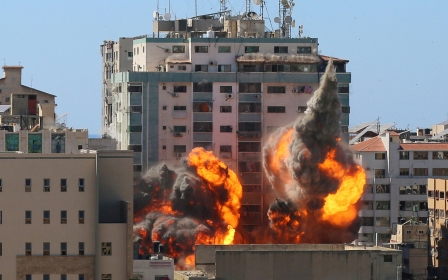Gaza: Hamas denies Israeli claims it hides military sites in civilian areas

A spokesman for Hamas, which governs the Gaza Strip, has denied claims by the Israeli army that the movement's armed wing, the Qassam Brigades, has deliberately hidden military sites in civilian areas in the besieged enclave.
In a press release on Thursday, Abu Obeida said that allegations made on Wednesday that Hamas had constructed military sites, infrastructure and tunnels near to and underneath residential areas in Gaza were "pure lies and misinformation".
Among the list of alleged sites, senior members of the Israeli army's Southern Command said Hamas had dug an underground tunnel near the Pepsi factory in the Tapah neighbourhood of Gaza City.
The officials said the tunnel, which they claim is used to store ammunition and house Hamas operatives, passes near a school which is used as a shelter for civilians under an agreement between Israel and UNRWA, the UN's Palestinian refugee agency.
The Israeli army claims that another tunnel it has discovered passes near UNRWA's main headquarters, potentially endangering personnel there.
According to Haaretz, the Israeli claims are the latest move in a bid to garner international legitimacy for any upcoming military operations in Gaza.
The Israeli newspaper said incidents such as the attack on the building in Gaza housing the Associated Press news agency during Israel's offensive against the enclave in 2021, which was condemned by the international community, had taught Israel it needed to take the initiative in trying to shape public opinion.
Israel claimed at the time that Hamas was operating out of several floors in the building, an allegation denied by the movement.
Haaretz said: "The IDF [Israeli army] is now trying to anticipate and show how Hamas operates in the civilian space...
"The security establishment says that the move is carried out regularly as part of preparations for possible fighting in the Strip."
'Army wants to justify targeting civilians'
The Israeli claims against Hamas were made in a co-ordinated move on Wednesday, with the Israeli army, government ministries and Israeli diplomatic posts around the world involved. Video clips alleged Hamas had built military sites near mosques, schools, hospitals and clinics.
In response to the claims, Obeida said: "These allegations are not surprising, because the enemy's army wants to justify targeting civilians."
Hamas spokesman Hazem Qassem said Israel's allegations were "an expression of the real crisis it was facing from human rights institutions and international bodies".
Last month, UN investigators concluded that Israel's occupation and discrimination against Palestinians were the main causes of the endless cycles of violence in Israel and Israeli-occupied territory.
The investigators were appointed last year by the United Nations Human Rights Council (UNHRC) to probe "all underlying root causes" in the decades-long conflict.
Earlier this year, the UN special rapporteur on human rights in the occupied Palestinian territories also submitted a report to the UNHRC that concluded that Israel's treatment of Palestinians amounts to apartheid.
Last year, the UNHRC agreed to launch an investigation with a broad mandate to probe all alleged violations Israel had committed against Palestinians following its 2021 offensive on Gaza, which saw at least 260 Palestinians killed, and 13 people in Israel.
Israel stated that it would not cooperate with the probe, rebuking the investigation and saying the UN body was unfairly biased against Israel.
Middle East Eye propose une couverture et une analyse indépendantes et incomparables du Moyen-Orient, de l’Afrique du Nord et d’autres régions du monde. Pour en savoir plus sur la reprise de ce contenu et les frais qui s’appliquent, veuillez remplir ce formulaire [en anglais]. Pour en savoir plus sur MEE, cliquez ici [en anglais].




